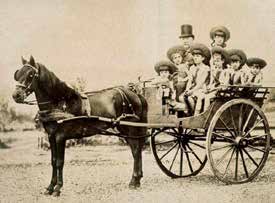How Much Weight Should My Horse Pull?
By Dana BRight
Article from May 2022 ADS Whip magazine, Volume 50, #2

Probably the first question an aspiring driver asks concerns appropriate weight for their horse to pull. They may have a carriage purchase in mind, or have visions of taking all of their children and their friends on drives, when someone asks, “Are you sure that’s an appropriate load for your horse to pull?” There is a lot of anecdotal advice out there, with no documented evidence; or documented studies mostly done on draft horses that don’t necessarily translate to the type of work sport horses are asked to do.
There is no simple answer to the question “how much can my horse pull?” This has been the subject of many studies in the past, when a horse’s pulling strength was essential for commerce, agricultural work and transportation.
There are many factors to take into account when trying to estimate how much your horse can or should be asked to pull. The first bit of information you need is an estimate of your animal’s weight. You can use a weight tape, but those only measure heart girth and are not as accurate as the following formula for horses of varying body types. You need to measure your horse’s heart girth and body length in inches. Then, multiply the heart girth (in inches) by the heart girth, and that number by the body length (also in inches) then divide that by 330 to get a weight in pounds.
This formula works for horses over the age of one. There are different weight estimate numbers for yearlings (divide by 301) and weanlings (divide by 280), but that is irrelevant to this article since yearlings and weanlings aren’t ready to pull weight. A common and pervasive guideline for weight pulling, for “continuous work with occasional heavy pulling and short rests” says:
• On a flat, smooth road a horse can pull up to three times its own weight.
• When roads are bad or hilly, up to twice its weight, and
• When roads are bad, or on fields, sandy going, hills: up to its own weight.
There is not source for this information given, so one would assume it comes from experience of those actually using horses as transportation.
Let’s look at factors that need to be considered when calculating how much your horse should be asked to pull. The horse’s size, breed, conformation, age, level of training, fitness level and temperament come into play. Some breeds of horses are built more powerfully than others. Natural ability needs to be enhanced by conditioning along with a good health management program.
The driver’s skill affects the ease of the horse’s job. If the horse is guided through smooth starts and stops, he will be less stressed. Timely use of the brake according to terrain needs will ease the work. Other factors that can be controlled by the driver for the benefit of the horse are intended use: from recreation to competition; the speed at which the work occurs and the duration of the work and number of passengers. Recreational use doesn’t imply less stress on the horse, but the competition needs of completing a task at a set speed and time don’t apply as much. The driver also needs to make sure appropriate harness is fitted to make the job of pulling easier; a very narrow breastplate doesn’t give as much bearing surface to push against as a wider one, or full collar. The angle of draft of the traces can affect pulling
power. A carriage with brakes that grab and don’t work properly will make it harder for the horse to pull. The load the horse pulls needs to be balanced. Carriage maintenance is also important, wheel bearings need to be lubricated as well as the fifth wheel; to minimize friction. Then there are factors less under the driver’s control.
Type of Footing can vary from pavement, to turf or grass, gravel, sand, manmade fiber arena footing, or plain dirt. A firm surface gives less rolling resistance to wheels. As a surface gets softer and deeper, more rolling resistance occurs. Choosing the appropriate design of wheels for average footing where you drive can make pulling easier. Many drivers in areas where the going is deeper and sandy have discovered pneumatic tires that don’t cut into the surface as deeply provide a smoother ride. Wheel selection also includes the appropriate diameter of wheel. Larger diameter wheels tend to go over ground changes more smoothly than smaller diameter wheels.
Terrain also affects footing. A perfectly smooth road becomes more challenging when inclines increase in angle and length. If a horse is used to working on flat terrain, going to hillier terrain without added conditioning will be a challenge.
Weather will modify footing in several ways. Rain creates mud. Cold and rain leads to ice. Snow changes traction and work load. Indoor footing stays more consistent than outdoor. A rough road surface increases effort needed to pull.
Weather also causes changes in the horse’s metabolic response to work. Your horse will respond to changes in temperature and humidity through adjusting his respiration and heat control mechanisms. Sudden changes in either temperature or humidity will stress even a well-conditioned horse. Sweating might not dissipate heat produced by working muscles quickly enough, and your horse might invert respiration and heart rate to try to get more oxygen into his system.
There are several methods to ensure a horse has the necessary traction to deal with the footing he is working on. Slippery surfaces create more work especially when starting, slowing down, or stopping a load. Studs, borium or even a simple inner rim on a shoe add traction to a plain shoe. Barefoot horses may need hoof boots when dealing with rough terrain. Using suitable traction can help a horse work more confidently when the possibility of slipping or falling is lessened. On the other hand, the horse in motion needs to have a little bit of “slip” allowed rather than total sudden planting of the hoof. It can be tempting to use too much traction via big spots of borium or studs which are too large. There is no easy formula that answers the question “How much weight should my horse pull? Researching this article raised many questions. There is not a lot of researched information regarding weight capacity of VSEs/Miniature horses. (The ADS Education Committee is continuing to track information and would love membership input, email us.) Take the above factors into consideration, know your horse’s weight and your carriage’s weight, then add the weight of possible additional passengers. Using the guideline of 3 times, twice and equal to your horse’s weight should help you decide what is appropriate for your horse and his working challenges.
In the 1800’s heyday of carriage driving, adults driving very small ponies was virtually unheard of. Small ponies were “toys” for privileged children. Only in the last 50-60 years or so has it been more common to see adults driving miniature horses and ponies. It really is necessary to be aware of the signs of horses being over faced. This doesn’t just apply to small ponies and minis. A full-sized horse or a draft horse with a vehicle that is too big or a hauling a large quantity of passengers can also be over faced.
Advice from veterinarians and experienced carriage drivers includes:
• “Hopping” to break the load free. This can be seen when the horse goes from the halt to the walk or even from the walk to the trot. If they hop into the up transition, they are having a hard time moving the load forward and therefore will use that hop as extra power.
• Rearing. Along the same lines as hopping, some horses get so frustrated with not being able to move the load forward that they resort to going up instead.
• “Digging in” on the tip toes. When the load is just too heavy to use the powerful rear end of the horse, the horse resorts to leaning into the load with the front end and it may look like he is literally on his toes. This can be seen with draft horses at pulling contests. We don’t want to see this with our recreational and competitive horses, though.
• Bad attitude when tacking up or working. While a lousy demeanor can have a number of factors, such as ill-fitting equipment, health concerns, etc., it can also signal that your horse is frustrated with his job because he knows he can’t do it effectively. If he expects that the coming exercise is going to be painful or challenging, he may be trying to tell you that he can’t do it or isn’t ready for it.
• “Running out of gas”. Some horses have a good sense of when they are just “done” while others seem to want to keep going until they keel over. Temperament can play a part in this.
If you find your horse doing any of the above behaviors, figure out why he might be doing so. Then make the changes needed to better serve the horse’s ability to pull the load without stress.
